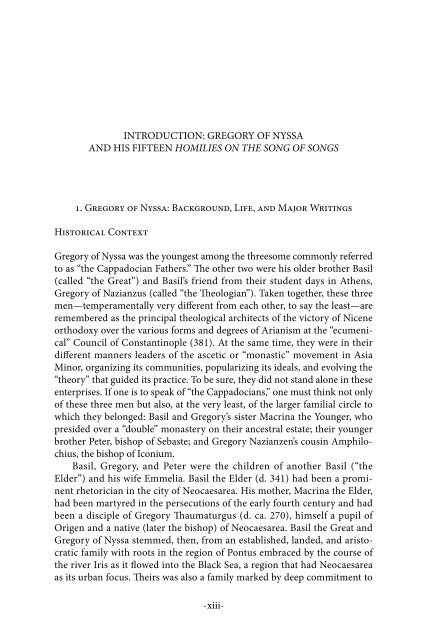gregory of nyssa: homilies on the song of songs - Society of Biblical ...
gregory of nyssa: homilies on the song of songs - Society of Biblical ...
gregory of nyssa: homilies on the song of songs - Society of Biblical ...
Create successful ePaper yourself
Turn your PDF publications into a flip-book with our unique Google optimized e-Paper software.
INTRODUCTION: GREGORY OF NYSSA<br />
AND HIS FIFTEEN HOMILIES ON THE SONG OF SONGS<br />
1. Gregory <str<strong>on</strong>g>of</str<strong>on</strong>g> Nyssa: Background, Life, and Major Writings<br />
Historical C<strong>on</strong>text<br />
Gregory <str<strong>on</strong>g>of</str<strong>on</strong>g> Nyssa was <strong>the</strong> youngest am<strong>on</strong>g <strong>the</strong> threesome comm<strong>on</strong>ly referred<br />
to as “<strong>the</strong> Cappadocian Fa<strong>the</strong>rs.” The o<strong>the</strong>r two were his older bro<strong>the</strong>r Basil<br />
(called “<strong>the</strong> Great”) and Basil’s friend from <strong>the</strong>ir student days in A<strong>the</strong>ns,<br />
Gregory <str<strong>on</strong>g>of</str<strong>on</strong>g> Nazianzus (called “<strong>the</strong> Theologian”). Taken toge<strong>the</strong>r, <strong>the</strong>se three<br />
men—tempera mentally very different from each o<strong>the</strong>r, to say <strong>the</strong> least—are<br />
remembered as <strong>the</strong> principal <strong>the</strong>ological architects <str<strong>on</strong>g>of</str<strong>on</strong>g> <strong>the</strong> victory <str<strong>on</strong>g>of</str<strong>on</strong>g> Nicene<br />
orthodoxy over <strong>the</strong> various forms and degrees <str<strong>on</strong>g>of</str<strong>on</strong>g> Arianism at <strong>the</strong> “ecumenical”<br />
Council <str<strong>on</strong>g>of</str<strong>on</strong>g> C<strong>on</strong>stantinople (381). At <strong>the</strong> same time, <strong>the</strong>y were in <strong>the</strong>ir<br />
different manners leaders <str<strong>on</strong>g>of</str<strong>on</strong>g> <strong>the</strong> ascetic or “m<strong>on</strong>astic” movement in Asia<br />
Minor, organizing its communities, popularizing its ideals, and evolving <strong>the</strong><br />
“<strong>the</strong>ory” that guided its practice. To be sure, <strong>the</strong>y did not stand al<strong>on</strong>e in <strong>the</strong>se<br />
enterprises. If <strong>on</strong>e is to speak <str<strong>on</strong>g>of</str<strong>on</strong>g> “<strong>the</strong> Cappadocians,” <strong>on</strong>e must think not <strong>on</strong>ly<br />
<str<strong>on</strong>g>of</str<strong>on</strong>g> <strong>the</strong>se three men but also, at <strong>the</strong> very least, <str<strong>on</strong>g>of</str<strong>on</strong>g> <strong>the</strong> larger familial circle to<br />
which <strong>the</strong>y bel<strong>on</strong>ged: Basil and Gregory’s sister Macrina <strong>the</strong> Younger, who<br />
presided over a “double” m<strong>on</strong>astery <strong>on</strong> <strong>the</strong>ir ancestral estate; <strong>the</strong>ir younger<br />
bro<strong>the</strong>r Peter, bishop <str<strong>on</strong>g>of</str<strong>on</strong>g> Sebaste; and Gregory Nazianzen’s cousin Amphilochius,<br />
<strong>the</strong> bishop <str<strong>on</strong>g>of</str<strong>on</strong>g> Ic<strong>on</strong>ium.<br />
Basil, Gregory, and Peter were <strong>the</strong> children <str<strong>on</strong>g>of</str<strong>on</strong>g> ano<strong>the</strong>r Basil (“<strong>the</strong><br />
Elder”) and his wife Emmelia. Basil <strong>the</strong> Elder (d. 341) had been a prominent<br />
rhetorician in <strong>the</strong> city <str<strong>on</strong>g>of</str<strong>on</strong>g> Neocaesarea. His mo<strong>the</strong>r, Macrina <strong>the</strong> Elder,<br />
had been martyred in <strong>the</strong> persecuti<strong>on</strong>s <str<strong>on</strong>g>of</str<strong>on</strong>g> <strong>the</strong> early fourth century and had<br />
been a disciple <str<strong>on</strong>g>of</str<strong>on</strong>g> Gregory Thaumaturgus (d. ca. 270), himself a pupil <str<strong>on</strong>g>of</str<strong>on</strong>g><br />
Origen and a native (later <strong>the</strong> bishop) <str<strong>on</strong>g>of</str<strong>on</strong>g> Neocaesarea. Basil <strong>the</strong> Great and<br />
Gregory <str<strong>on</strong>g>of</str<strong>on</strong>g> Nyssa stemmed, <strong>the</strong>n, from an established, landed, and aristocratic<br />
family with roots in <strong>the</strong> regi<strong>on</strong> <str<strong>on</strong>g>of</str<strong>on</strong>g> P<strong>on</strong>tus embraced by <strong>the</strong> course <str<strong>on</strong>g>of</str<strong>on</strong>g><br />
<strong>the</strong> river Iris as it flowed into <strong>the</strong> Black Sea, a regi<strong>on</strong> that had Neocaesarea<br />
as its urban focus. Theirs was also a family marked by deep commitment to<br />
-xiii -
















